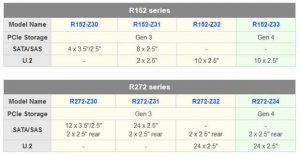Gigabyte Technology Unveils 6 Rackmount High-Density Servers for AMD EPYC Platform
R182-Z93, R282-Z94, R152-Z33, R272-Z34, H262-Z6A, H262-Z6B models, with support of PCIe Gen 4 for front drive bays and onboard M.2 slots, and for Broadcom Tri-Mode storage adapter
This is a Press Release edited by StorageNewsletter.com on October 19, 2020 at 2:28 pmGigabyte Technology Co., Ltd. announced 6 rack and high-density servers (R182-Z93, R282-Z94, R152-Z33, R272-Z34, H262-Z6A, H262-Z6B) for the AMD EPYC platform that garner considerable boosts in high-bandwidth flash storage, as well as flexibility for data center needs.
The updated technology in the servers add performance as they target Hyper-Converged Infrastructure, virtualization, business-critical workloads, and more.
Key features of servers:
-
All servers support PCIe Gen 4 for all front drive bays and onboard M.2 slots
-
Broadcom Tri-Mode storage adapters supported: R152-Z33, R272-Z34, R182-Z93 and R282-Z94
-
All servers have silicon-based hardware ‘Root of Trust’
-
Green tabs on bays to indicate PCIe Gen 4 U.2
Storage flexibility and RAID:
As part of the evolving nature of drives in high-performance workload servers, the company has included support for Tri-Mode storage adapters. This technology allows for the use of PCIe, SATA, or SAS storage devices in bays connected via an adapter in a PCIe slot. Fault-tolerant functionality is also available for protection of data. In a 1U chassis (R152 or R182) a single Broadcom adapter is supported, and in 2U chassis (R272, R282) 2 adapters are supported. Broadcom storage adapters supported by R152-Z33, R272-Z34, R182-Z93 and R282-Z94.
Secure boot process:
The firm has begun implementing a security module in the Socket-on-Chip (SoC) to ensure a secure boot process. As a system turns on, the security subsystem initializes to protect vs. firmware attacks by checking BMC/BIOS’s encrypted signature and SPI flash for compromised firmware. This Root of Trust (RoT) is on all 6 servers, more to come.
Dual AMD EPYC – R-series servers:

The 1U R182-Z93 and 2U R282-Z94 are designed for dual AMD EPYC 7002 series processors with 32 DIMM slots available, and each processor can run 16DIMMs of 3,200MHz DDR4 with a BIOS setting change. As well, the 32 DIMM slots support up to 8TB of DDR4 memory. The 2 servers mostly differ in terms of their storage capacity and number of expansion slots, while both have additional support for PCIe Gen4. The R182-Z93 favors expansion and mezzanine slots over storage capacity, and it has support for up to 10xU.2 drives and expansion slots: 2xfull-height half-length PCIe (Gen4 x16), 1xOCP 3.0 (Gen4 x16), 1xOCP 2.0 (Gen3 x8). On the other hand, the storage favoring R282-Z94 supports 24xU.2 drives and 2xSATA/SAS drives, and 1xfull-height half-length PCIe (Gen4 x16) slot.
The table below compares the rack servers to others in their series, based on storage.
Single AMD EPYC – R-series servers:
 The 1U R152-Z33 and 2U R272-Z34 are designed for single AMD EPYC 7002 series processors with 16 DIMM slots, and up to 4TB DDR4 at 3,200MHz. The 1U R152-Z33 design has a smaller footprint, as the 1U form factor packs in less drive bays, 10×2.5” Gen 4 U.2, for cost savings compared to the R272-Z34 with 24xU.2 and 2×2.5” SATA/SAS bays. As well, both servers have 2xM.2 slots (Gen4 x4) on the motherboard. The R152-Z33 has one full-height half-length PCIe (Gen 4 x16) slot, and the R 272-Z34 has one PCIe (Gen 4 x8) low profile slot. As for networking, both servers come with dual 1GbE LAN ports.
The 1U R152-Z33 and 2U R272-Z34 are designed for single AMD EPYC 7002 series processors with 16 DIMM slots, and up to 4TB DDR4 at 3,200MHz. The 1U R152-Z33 design has a smaller footprint, as the 1U form factor packs in less drive bays, 10×2.5” Gen 4 U.2, for cost savings compared to the R272-Z34 with 24xU.2 and 2×2.5” SATA/SAS bays. As well, both servers have 2xM.2 slots (Gen4 x4) on the motherboard. The R152-Z33 has one full-height half-length PCIe (Gen 4 x16) slot, and the R 272-Z34 has one PCIe (Gen 4 x8) low profile slot. As for networking, both servers come with dual 1GbE LAN ports.
H-series servers:

Designed for HCI and HPC, the 2U 4node H-series offers flexibility for scaling out. One of the benefits of the H-series, and what makes it a choice for rack size reduction, is the possibility for up to 4 nodes with focus on compute, storage, or networking. The H262-Z6A and H262-Z6B support dual AMD EPYC 7002 series processors. Both servers, at a per node level, support 1x6DIMMs of DDR4 up to 3,200MHz. However, the H262-Z6B can support 280W EPYC processors (ambient 25°C) as the server has less front bay drives than the H262-Z6A. Drawing in higher, less impeded, airflow allows for ample cooling of max TDP processors in the H262-Z6B. On the other hand, the H262-Z6A focuses more on storage and thus is able to support only up to 240W EPYC processors (ambient 30°C). In terms of slots, per node, both servers support 2xlow profile half-length PCIe (Gen4 x16) slots and 1xOCP 3.0 mezzanine (Gen4 x16).
The following table compares the stack of H262 series servers.
Remote and multiple server management:
As part of its proposition, the company provides Gigabyte Management Console (GMC) for BMC server management via a web browser based platform. Whether for server monitoring, updating BIOS and firmware, or remote management, GMC delivers. Additionally, GSM software is free to download and used to monitor and manage multiple servers. GMC and GSM offer value while reducing license and customer maintenance costs.
Read also:
Gigabyte Aorus RAID SSD 2TB With PCIe 3.0 Performance
Delivering 6.2GB/s R/W speeds
January 31, 2020 | Press Release
Gigabyte TO22-Z61 and TO22-Z62 AMD EPYC Compute Nodes to Racklution-OP OCP Products
Features dual EPYC Naples processor sockets for compute nodes with high core counts and memory capacity, and offers storage options (all flash or mixed SATA/SAS+flash).
January 23, 2019 | Press Release


















 Subscribe to our free daily newsletter
Subscribe to our free daily newsletter

